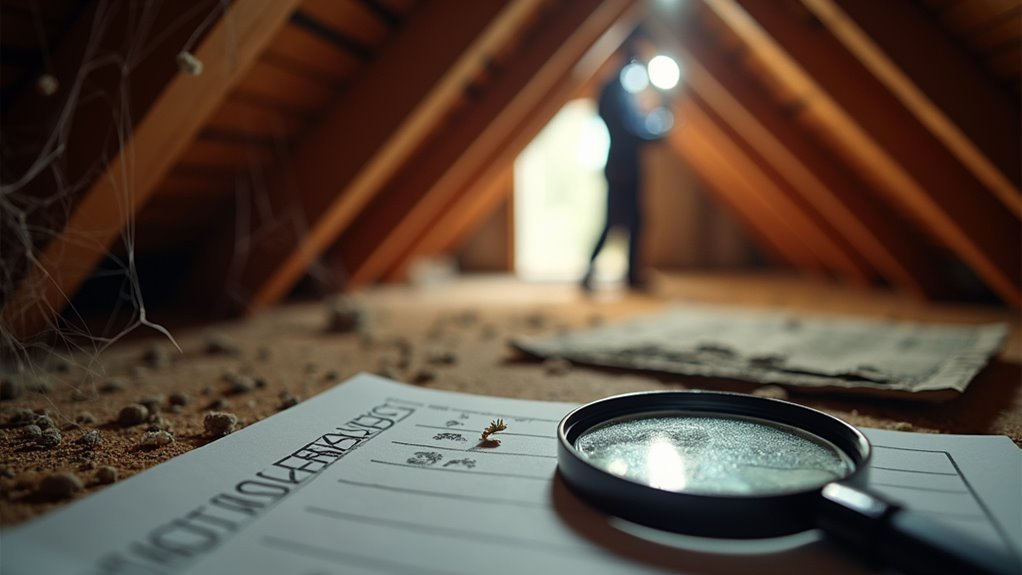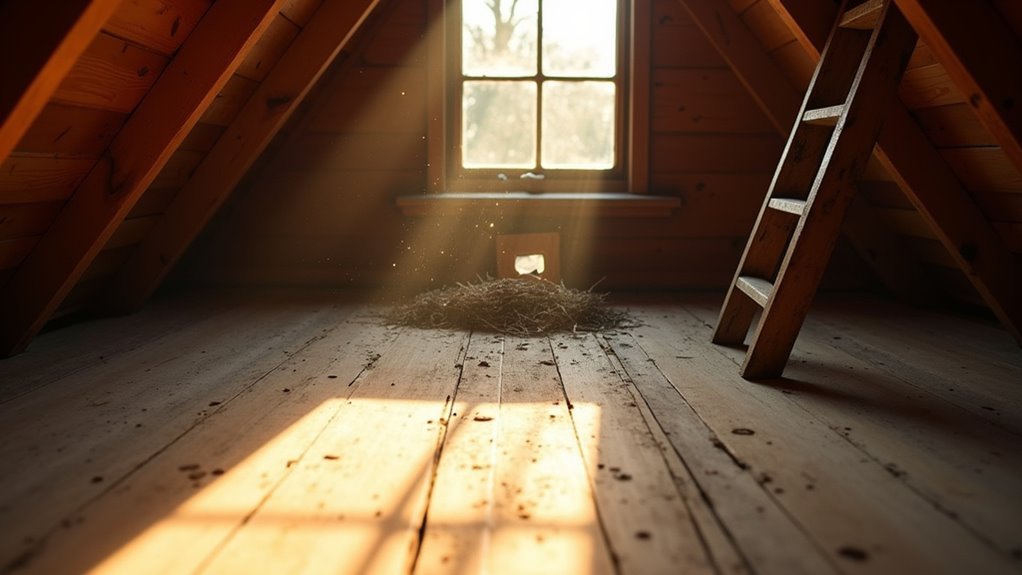You should schedule quarterly attic pest inspections because they prevent small problems from becoming expensive infestations that threaten your home’s structural integrity and your family’s health. Early detection costs only $75-$100 compared to $100-$300 for extermination treatments, while termites alone can cause thousands in damage by consuming 5 grams of wood daily. Professional inspectors identify entry points, nesting areas, and health hazards like disease-carrying droppings that compromise indoor air quality. The sections below reveal exactly how this proactive approach protects your investment.
Early Detection Prevents Major Infestations in Attic Spaces

While attics offer the perfect refuge for rodents, insects, and other unwanted guests, you can stop small problems from becoming costly nightmares through quarterly inspections.
Early detection allows you to spot warning signs like droppings, gnaw marks, and nests before pests establish major colonies in your home’s upper levels.
Catching pest warning signs early prevents small attic problems from turning into major infestations that cost thousands to eliminate.
These routine checks help you identify vulnerable entry points where creatures slip through gaps in your roofing or siding.
When you catch infestations early, you’ll avoid expensive pest control treatments and prevent health risks from disease-carrying invaders.
Small problems require simple solutions, but established colonies demand extensive interventions that strain your budget and disrupt your household for weeks.
Protecting Your Home’s Structural Integrity From Pest Damage
Your attic’s wooden beams and load-bearing components face serious threats from termites and other wood-destroying insects that can compromise your home’s structural foundation.
These pests silently weaken critical support structures, creating safety hazards and requiring expensive repairs that could’ve been prevented with regular monitoring.
Quarterly inspections help you spot early warning signs of wood-destroying insect activity before they cause irreversible damage to your home’s framework.
Termite Structural Damage Prevention
Since termites feed relentlessly on wood structures, they can silently compromise your home’s foundation, support beams, and load-bearing walls without showing visible signs for months. A single colony consumes approximately 5 grams of wood daily, making termite structural damage accumulate rapidly when left unchecked.
| Inspection Frequency | Risk Level | Potential Damage Cost |
|---|---|---|
| Never | Extremely High | $15,000+ |
| Annual | High | $8,000-$15,000 |
| Semi-Annual | Moderate | $3,000-$8,000 |
| Quarterly | Low | $500-$3,000 |
Regular inspections help you identify early signs of pest activity like mud tubes and frass before costly damage occurs. Professional services from pest control companies can detect termites entering through foundation cracks and prevent future infestations, making proactive measures far more economical than reactive repairs.
Wood-Destroying Insect Detection
Beyond termites, several other wood-destroying insects threaten your home’s structural integrity through different attack methods and feeding patterns.
Carpenter ants excavate galleries through wooden structures, while powder post beetles create tiny holes that weaken support beams over time. Your attic provides the perfect environment for these pests to establish colonies undetected.
Quarterly Pest Control inspections enable early detection of wood-destroying insects before they cause extensive structural damage.
During regular inspections, professionals identify telltale signs like sawdust piles, discarded wings, and hollow-sounding wood. They’ll locate mud tubes termites use for travel and spot carpenter ant frass near damaged areas.
Since homes with previous pest activity face higher reinfestation risks, consistent monitoring helps prevent future infestations and protects your investment from costly repairs.
Load-Bearing Component Protection
When pests target your home’s load-bearing components, they’re attacking the very foundation of your property’s structural integrity. Termites and carpenter ants silently weaken wooden beams and joists, often causing extensive structural damage before detection. Regular inspections through quarterly visits help identify early signs of pest infestation before costly repairs become necessary.
| Load-Bearing Component | Common Pest Threats |
|---|---|
| Floor joists | Termites, carpenter ants |
| Support beams | Subterranean termites |
| Roof trusses | Drywood termites |
| Foundation sills | Carpenter ants, beetles |
| Wall studs | Multiple wood-destroyers |
A professional pest control company can implement targeted pest control methods during these inspections. With 600,000 homes experiencing termite damage annually and average repairs exceeding $3,000, proactive monitoring protects your investment and prevents potential safety hazards from compromised structural elements.
Health Risks Associated With Attic-Dwelling Pests
When pests like rodents, bats, and raccoons take up residence in your attic, they create serious health hazards that can affect your entire family.
You’re exposed to dangerous diseases through direct contact with droppings, contaminated air particles, and allergens that circulate throughout your home’s ventilation system.
These hidden health threats often go undetected until respiratory problems, allergic reactions, or more severe illnesses develop in household members.
Disease Transmission Pathways
Although many homeowners focus on the structural damage pests cause, the health risks from disease transmission present far more serious concerns.
Attic pests create multiple pathways for spreading dangerous pathogens throughout your home. Rodents transmit hantavirus and other diseases through their droppings, urine, and saliva, which become airborne when disturbed.
Bats carry histoplasmosis in their guano, creating respiratory hazards when spores circulate through your ventilation system.
Cockroaches spread allergens and bacteria that trigger asthma and gastrointestinal illnesses. These health risks multiply when pests contaminate insulation and air ducts with pathogens.
Regular pest control through quarterly inspections enables early detection of infestations before disease transmission occurs.
Professional pest control services can identify contamination sources and eliminate these dangerous pathways, protecting your family’s health.
Respiratory Health Complications
Attic-dwelling pests create severe respiratory hazards that can compromise your family’s breathing and lung health for years.
When rodents and cockroaches inhabit your attic, they release dangerous allergens through their droppings and urine. These particulates become airborne and infiltrate your home’s ventilation system, triggering asthma attacks and bronchitis episodes.
Cockroach allergens pose particularly serious threats to children with existing respiratory conditions. You’ll notice worsening symptoms as these potent triggers accumulate in your living spaces.
Additionally, attic-dwelling pests promote mold development, creating another layer of respiratory health complications.
Regular inspections by professional pest control services help identify infestations before they escalate into major health crises.
Don’t wait until family members develop chronic breathing problems—quarterly attic assessments protect everyone from these preventable pests and their harmful respiratory effects.
Contamination and Allergens
While respiratory issues represent just one dimension of pest-related health risks, contamination and allergens create a broader spectrum of dangers that threaten your family’s wellbeing. Attic-dwelling pests contaminate insulation and air ducts with droppings, urine, and nesting materials, compromising indoor air quality throughout your home.
| Pest Type | Primary Health Risks |
|---|---|
| Rodents/Bats | Bacterial contamination, airborne pathogens |
| Cockroaches | Asthma triggers, severe allergic reactions |
| Dust Mites | Respiratory allergens, skin irritation |
Without proper pest control, infestations multiply rapidly, dramatically increasing allergen volumes. Harmful bacteria and pathogens accumulate, spreading contamination to surfaces and air systems. Regular inspections identify pest issues early, preventing widespread contamination before it escalates into serious health threats.
Seasonal Pest Activity Patterns in Attic Environments
Because attic environments offer consistent warmth and protection from harsh weather, they become magnets for various pests throughout the year, with activity levels shifting dramatically based on seasonal conditions.
Seasonal patterns show rodents invading during late fall and winter for nesting, while insects like cockroaches seek warmth simultaneously. Termites can enter through foundation cracks or roof gaps, thriving in winter conditions and causing hidden damage.
Regular visits during attic inspections help you identify signs of pests like droppings and gnaw marks that become more prevalent in colder months.
Proactive measures through quarterly monitoring can prevent infestations before they escalate. Since many pests lay eggs during winter, pest activity surges as spring temperatures rise, making winter detection vital for stopping population explosions.
Cost-Effective Prevention vs. Expensive Remediation

Investing in quarterly attic inspections offers significant financial advantages compared to dealing with full-blown pest infestations. You’ll pay $75-$100 per quarterly inspection versus $100-$300 for single extermination treatments.
These proactive measures help prevent infestations before they escalate into costly problems.
Termites exemplify why cost-effective prevention matters. They can cause significant damage while remaining undetected for months, with treatment costs reaching thousands of dollars. Without quarterly inspections, you’re risking expensive repairs to insulation, wiring, and structural components.
Beyond property damage, pest infestations create health risks that may result in medical expenses. Regular inspections maintain a pest-free environment, protecting both your home’s integrity and your family’s wellbeing.
You’ll save substantially by detecting issues early rather than facing major remediation costs later.
Professional Inspection Benefits Over DIY Approaches
Although DIY attic inspections might seem cost-effective, professional pest inspectors deliver superior results through specialized training and advanced detection methods.
You’ll miss critical entry points and nesting areas that trained professionals easily identify using specialized equipment.
Professional services provide extensive evaluations beyond basic pest problems. They assess insulation integrity and structural damage that untrained eyes overlook.
While you might spot obvious signs, professionals detect subtle indicators of early infestations, preventing costly future problems.
Regular professional inspection offers warranties and guarantees that DIY approaches can’t match. You’re protected against future pest problems with documented service records.
These experts use advanced tools and techniques that guarantee thorough coverage, while your guesswork approach may leave dangerous gaps in detection and prevention strategies.
Creating a Proactive Attic Pest Management Strategy

Professional inspections form the foundation of effective attic pest control, but they’re only one component of a thorough management approach.
You’ll need extensive pest control plans that go beyond quarterly visits to maintain long-term protection. During inspections, professionals identify entry points and create tailored solutions specific to your home’s vulnerabilities. This proactive approach enables you to address potential problems before they escalate into costly infestations.
Your management strategy should include sealing identified access points, monitoring for new pest activity, and implementing preventive measures between professional visits.
Frequently Asked Questions
Is Quarterly Pest Control Necessary?
Yes, you’ll need quarterly pest control since many pests remain active year-round. Regular inspections catch early infestations, prevent costly damage, reduce health risks, and save money compared to emergency treatments.
Is Routine Pest Control Necessary?
You’ll find routine pest control absolutely necessary for protecting your home’s health and safety. It prevents minor issues from becoming costly infestations while detecting problems early before they cause significant structural damage.
What Is the Average Cost of Quarterly Pest Control?
You’ll typically pay $75 to $100 per quarterly pest control visit. This proves more economical than monthly services at $30-$50 each, while preventing costly severe infestations that’d require expensive one-time treatments.
How Many Times Should Pest Control Be Done?
You should schedule pest control quarterly, meaning four times per year. This frequency effectively prevents infestations, catches early pest activity, and maintains year-round protection against rapidly reproducing pests.
In Summary
You’ll protect your home’s value and your family’s health by scheduling quarterly attic pest inspections. Don’t wait until you’re facing expensive repairs or dangerous infestations. Regular professional inspections catch problems early, saving you thousands in remediation costs. You’ll stay ahead of seasonal pest cycles and maintain your home’s structural integrity. Take control of your attic’s condition now—establish a quarterly inspection routine that’ll keep pests out for good.





Leave a Reply